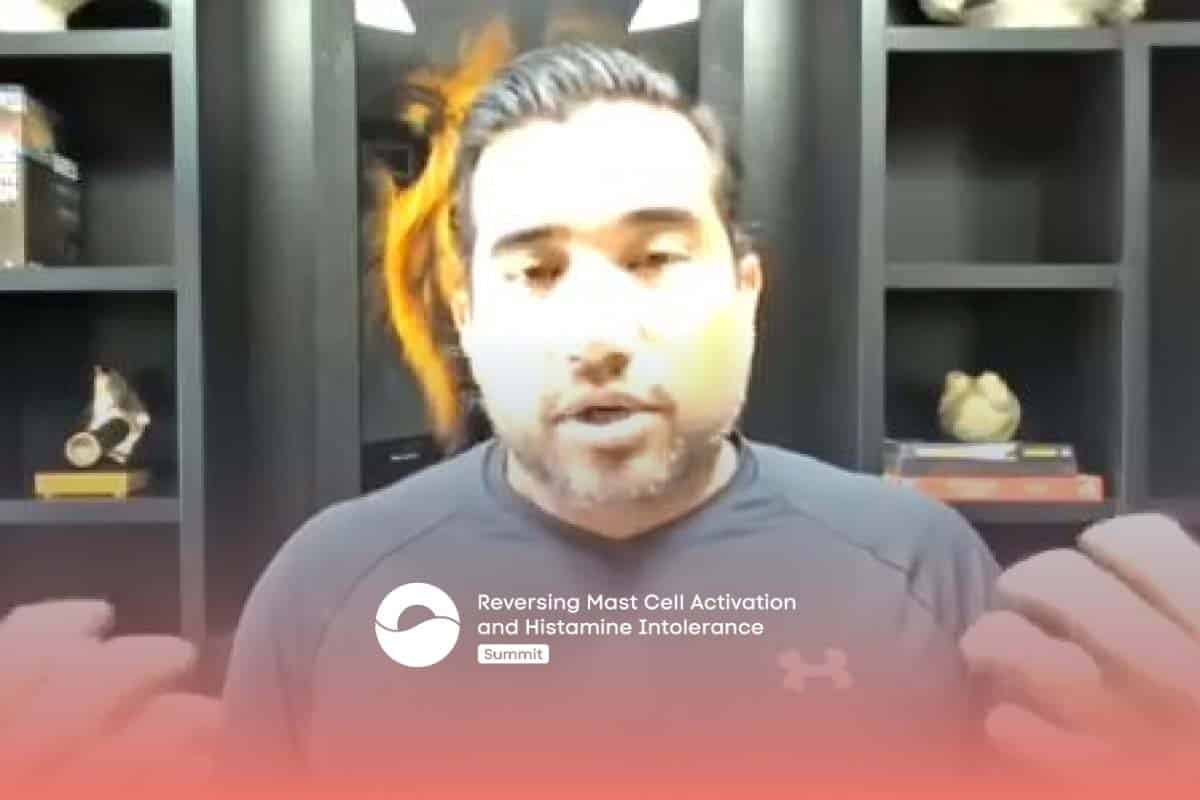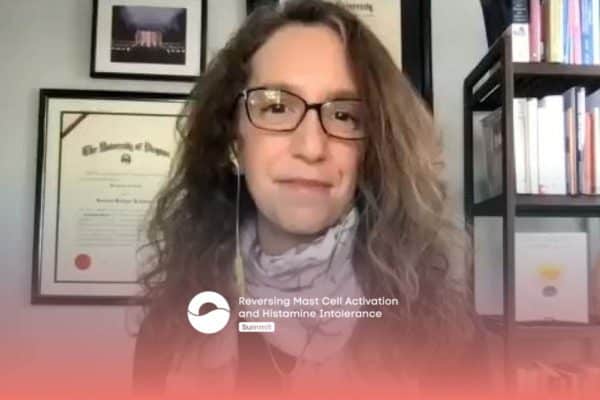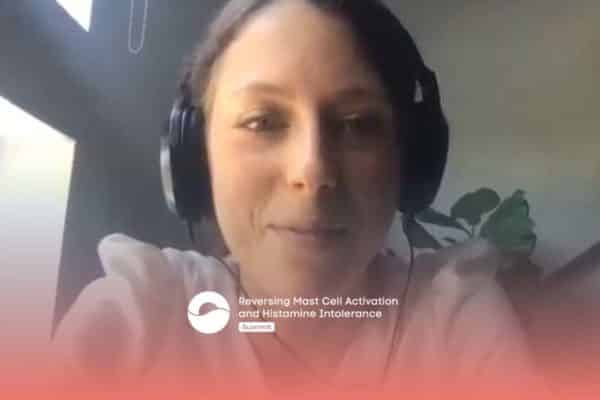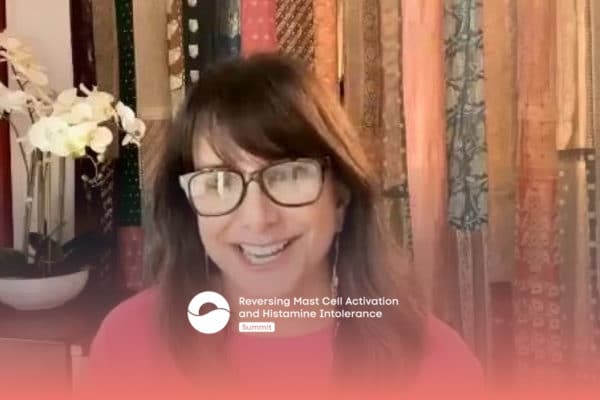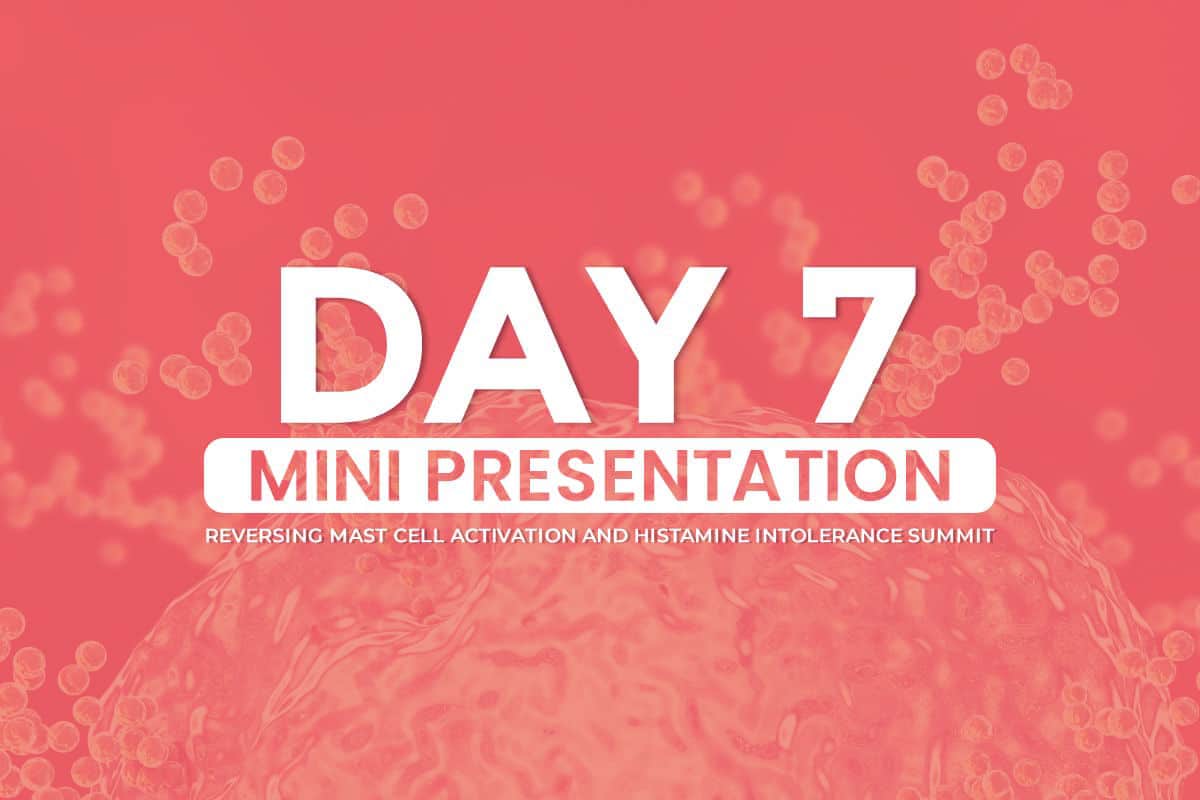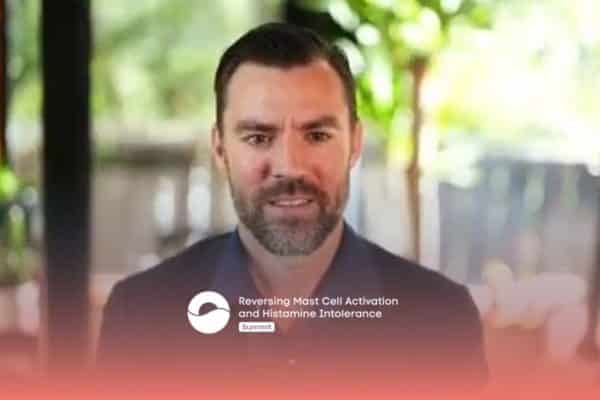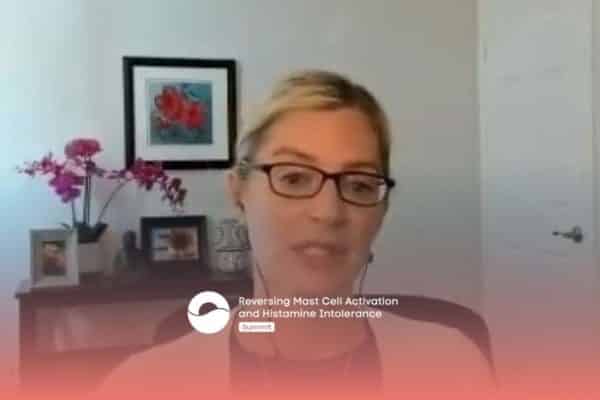Join the discussion below

Beth O’Hara is a Functional Naturopath, specializing in complex, chronic cases of Mast Cell Activation Syndrome, Histamine Intolerance, and Mold Toxicity. She is the founder and owner of Mast Cell 360, a Functional Naturopathy Practice designed to look at all factors surrounding health conditions – genetic, epigenetic, biochemical, physiological, environmental,... Read More

Kiran Krishnan is a Research Microbiologist and has been involved in the dietary supplement and nutrition market for the past 18 years. He comes from a University research background having spent several years with hands-on R&D in the fields of molecular medicine and microbiology at the University of Iowa. Kiran... Read More
- The microbiome-mast cell links
- Navigating intolerances to probiotics
- Better tolerated ways to reboot dysbiosis for sensitive people
Beth O’ Hara, FN
Welcome back to this episode of the reversing mast activation syndrome in histamine intolerance summit. I’m your host Beth O’Hara of Mast Cell 360. And this is gonna be a really interesting interview looking at the microbiome and the connections of it with mast cell activation syndrome and histamine intolerance. So for all of us, who’ve had GI issues really to mast cell. I think you wanna tune in and listen and get all of this interview because it’s gonna be pretty interesting. Wanna introduce her speaker. Says Kiran Krishnan, he’s a research microbiologist, and he spent several years with hands on experience in research and development and molecular medicine and microbiology at the University of Iowa. And then he established a clinical research organization where he is designed and conducted dozens of human clinical trials in human nutrition. And he’s the co-founder and chief scientific officer of a company you’ve probably heard of Microbiome Labs and he’s currently involved in 16 novel human clinical trials on probiotics and the human microbiome. He’s a scientific advisory board member or science advisor for seven other companies. So this is somebody who really has the scoop on what’s going on with gut dysbiosis and these particular organisms in our gut and how they affect our immune system and histamine intolerance. So thank you Kiran so much for being with us.
Kiran Krishnan
Beth, it’s a pleasure to be with you. Thank you for having me.
Beth O’ Hara, FN
And I always love to know, these aren’t your typical areas that people specialize in. There’s always a little story behind it. What got you so interested in the microbiome?
Kiran Krishnan
You know, I’ve been a nerd since the beginning, right? My mom’s a doctor. My dad was an engineer. So we’ve always been surrounded by science and I’ve always been fascinated by science. I was always one of those kids that never took anything for granted in terms of how things worked. And I wanted to know how the world around me worked and I always studied it and was curious about it. I always had an inkling towards the biological sciences. So when I started college, I was trying to figure out what I wanna major in what I wanna study. And I knew it was gonna be something in the biological science realm and maybe go into medicine afterwards, the first week in the dorms, they were playing this movie called “Outbreak”. If you remember that Morgan Freeman, Dustin Hoffman movie, about a pandemic outbreak, viral pandemic, if you will. That got me super excited.
I was like, that’s what I wanna do. I wanna chase viruses and so on. And find cures for infections. So that got me to apply for and enter the school of microbiology. Once you get into the world of microbiology, to me, the most fascinating aspect of it is just how much larger it is and how much more influential it is on absolutely everything around us, including the weather for example, there are microbes that form clouds in the sky and change weather patterns, so everything around us is impacted by microbes. It starts to become really fascinating that if you can understand microbes and work with microbes to a certain degree, you can make big changes in the world, starting with people’s health. And inevitably, when you go into research in microbiology, there’s a major focus on pathogens and things that make you sick. But at the end of the day, 99.9% of microbes that we’ve ever discovered, don’t make you sick. They’re either benign or beneficial. So I had an inkling towards going towards that 99.9% that doesn’t get as much attention as the 0.1%, that actually does make you sick. And as I started going into that realm and that area, then the human microbiome project kicked off, which was all about understanding this microbial universe within us, that how it impacts us and largely studying that other 99.9% that doesn’t make us sick or actually helps us function. So it was a natural fit for me to jump right into that.
And it’s a pioneering field, it’s an area that allows us to learn about ourselves in a much more profound way than we ever could imagine. So that’s the kind of thing that just gets me excited every single day. And one of the things I love about learning things like that and making those discoveries is teaching it, that’s one of my passions and that’s why I do so many lectures and programs like this as much as possible. So it was all a great serendipitous fit that as I was making my professional choices of where I wanted to hone in my skills, the NIH kicked off this amazing human microbiome project. And it became an amazing world of study for me.
Beth O’ Hara, FN
I remember when, I’m also a geek and get so excited and fascinated by these things. When I learned years ago that we are actually more microbes than we are human DNA. And if I have this right, correct me, if I’m wrong, we’re actually pound for pound more microorganisms than we are human themselves.
Kiran Krishnan
We are yeah. And it’s the invisible part of us, it’s probably the most influential part of us. It’s probably the thing that controls us the most, but it’s the thing you can’t see, you can cut yourself open and look at all the organ systems and nerves and vessels and all the complexity of our physiology that functions or causes us to function as human. But what you don’t see are the invisible drivers of all of that functionality, and it’s microbes. And you’re absolutely right that we have about 150 to 200 times more microbial DNA in our body than human DNA. Our genome is wholly inadequate to function. That was actually when I was in college. One of the labs I worked in was one of the labs that were part of the global human genome project, that was the project where they were trying to map out the entire human genome.
The assumption at that point was that for every functionality that we had, there a single gene, and there was some mutation of that gene that leads to disease, so the whole idea was for every disease that we deal with we’ll find a gene that drives it. That of course didn’t turn out to be true, though, was lots and lots and lots of diseases we deal with that have no genetic predisposition necessarily. And we also came to find out that the early estimations that humans probably have 150 to 200,000 functional genes was actually wholly exaggerated. We actually have only 22,000 functional genes. And that caused a big conundrum, which I recall very clearly when I was in academics at that time, because it caused this massive gap in understanding how we do what we do. 22,000 functional genes is not a lot when you consider an earthworm has about 30,000 functional genes. So how are we that much more sophisticated than an earthworm is when we don’t have the genetic material to be sophisticated. Well as it turns out then the human microbiome project revealed that we have 200 times more microbial DNA in our system, which means that at any given time, if you look at the chemistry in your blood and all the compounds that are conducting functions, more than 50% of those chemistries and those compounds are produced solely by the microbes in your system. We can’t gain them from food.
We can’t make ’em ourselves, we count on the microbes to do that for us. So we are a walking, talking rainforest. We are, there’s a term called holobiome, which is a super organism. We are an organism made up of thousands of other organisms working together in concert to advance the whole. And so it’s an absolutely fascinating area. And then when you dig into topics like the immune system, wow it becomes even more fascinating, because the microbiome and the immune system are the same system. We think of them as quite a bit different. We think, oh, bacteria, microbes, viruses over there, immune cells over here. In fact they fight with each other. They don’t, they’re actually part of the same system. They’re all microbes, they’re all cellular functions. So we can talk about that.
Beth O’ Hara, FN
Yeah and I can relate that for our audience and our community who already we’ve talked a lot about how we can’t separate the mast cells and the immune system from the nervous system. There’s this interwoven here. So now we’ve got this interweaving of the microbiome. And we think about the microbiome as being primarily, it’s talked about as the gut microbiome, but we have microorganisms that may keep our skin healthy. We have them in the bladder, in the vaginal canal, in all these areas to keep these tissues healthy. And then they are secreting things and they’re performing immune functions for us.
Kiran Krishnan
Yeah. They are in fact, I mean, so to talk about where all you have microbes, you have microbes everywhere in the body, even in your cerebral spinal fluid and our eyeballs in our blood. We used to think that the blood is sterile. You always hear this anecdotes. You are in a sterile, our brain. We’d never, ever imagined we’d have microbes living in our brain. It’s a scary thought. You’re like, oh my god, there’s bacteria viruses in the brain. Yes, there are. And they conduct very important functions in the brain. They are in the cerebral spinal fluid as well that feeds the brain. And so they’re everywhere. There’s actually one region in the body where you have a very low number, if any microbes at all. And that’s in the, there’s a mucosal layer that covers the GI tract and lots of other tissues called a mucin two layer. That is one area in the body that is relatively sterile. And in fact, if that area becomes compromised by having too many microbes in there, it sets you off all kinds of diseases, including immune dysfunctions.
So we’ll talk about how that’s connected as well, but you’re absolutely right that microbes are everywhere and microbes are in fact, the eyes and the ears of the immune system. They are the neighborhood watch of the immune system. I’ll give you an example. This is an analogy I used to try to explain what a daunting task the immune system has. So we just talked about how we are covered in microbes, on the outside, on the inside, every mucosal tissue, and all of that everything’s covered in microbes. So imagine you are an immune cell in the human body and your job is to protect your hosts from microbes, from viruses, bacteria, fungi, things that may infect and kill your host. All the while you are surrounded by microbes, it’s a 200,000 to one ratio. There are 200,000 times more microbes than there are immune cells to manage those microbes. And so the analogy I give to get people to wrap their head around that is imagine there’s a massive stadium with 200,000 fans in the stadium. There’s some festival or something going on, right? And you are the lone security guard in that sea of 200,000 people. And in that sea of 200,000 people, there’s one, maybe two people that have ill intent that plan on doing something bad in that region. But everyone looks about the same. How in the world would you ever police that area, right?
You’d have no shot at policing that sea of 200,000 people and finding the one person or the two people that have ill intent. The only way you could do it is if the other 199,998 people are on your side, they all have walkie talkies and are plugged into you and when they see something that’s unusual around them, they call you in and tell you exactly where that is. They are acting as your neighborhood watch. That’s exactly what’s happening with the microbiome and the immune system in your body. It’s absolutely impossible for your immune system to survey this entire structure with the number of immune cells that are present, especially given that the immune cells are surrounded by microbes already, so the way it actually works for the immune system to even function is there’s a deep relationship between the commensal organisms and the immune system where the commensal organisms are the first to detect any changes in the ecosystem.
Whether it’s a new virus that’s coming in or infectious bacteria or fungus, or an environmental toxin, something, whatever the bad trigger is, the microbes in that area detect the change first, they send out signals to recruit the immune system to that area. And that’s when the immune system goes to work. So that crosstalk and that relationship is critically important for the microbiome and the immune system to function properly. So in cases of immune dysfunction, when we think about things like mast cell activation and histamine intolerance and allergies, hypersensitivity responses, that’s a breakdown in that communication. And it occurs in a couple different ways. One, if you have the wrong microbes in that area, those microbes don’t want to recruit the immune system to the area because they themselves have ill intent. So these are opportunistic microbes. I give a example of a neighborhood watch, let’s say there’s a neighborhood. And one of the houses in the neighborhood, they’re doing something that they probably shouldn’t be doing. If they notice something out on the street that is not good, they’re less likely to call the police ’cause they don’t want to bring the attention to themselves either.
So if your gut is dysbiotic, your microbiome is dysbiotic and you have a lot of those opportunistic type organisms. They’re not gonna recruit the immune system and the immune cells to areas where infections and things are taking hold. That’s one thing. Number two, problematic microbes or dysbiotic microbes drive lots of inflammatory responses in the body. And part of that inflammatory response dysfunction is something called loss of tolerance where your immune system no longer has the knowledge of what to attack, what not to attack, what to tolerate, what not to tolerate. A lot of that teaching for the immune system comes from the microbiome, from the healthy commensals. They upregulate regulatory parts of the immune system like T reg cells or the Fox P three mechanisms, which helps the immune system understand what to attack and what not to attack. When that communication breaks down. Then the immune system simply attacks lots of things. So that’s where a lot of this IgE mast cell activation histamine response all starts to stem from is that loss in crosstalk between the microbiome and the immune system.
Beth O’ Hara, FN
It makes so much sense. And there are, I don’t even know how many hundreds of thousands of types of organisms that are normally found in our bodies hopefully found in our bodies and starting to shift this a little more into just looking at the gut microbiome. One of the first places people think to go when there’s dysbiosis is probiotics, but sometimes that backfires and particularly in our sensitive audience, there a lot of strains that they won’t tolerate. Can we talk about that more and what’s happening and why?
Kiran Krishnan
Yeah, there’s a couple of reasons for that. One of ’em is that some species do on their own microbes produce histamine, so if they are colonizing and driving histamine production in the system, then they’re actually gonna create more of that inflammatory response. That’s unfavorable, that’s already happening in the individual in a robust way. So that’s one way, the second way is if it’s a strain, that’s not necessarily recognized by the immune system. So one thing that’s really important between the microbiome and the immune system. And remember I talk about that one layer of mucus that’s relatively sterile, and that will focus in on the gut lining at that. So you’ve got the intestinal epithelium, which are the cells that act as a barrier. They sit shoulder to shoulder like this. And in between them as a tight junctions, that’s where the gaps open when you have really bad leaky gut, but it’s one cell layer thick of intestinal cells that form this layer, this bridge, if you will, or sorry, a barrier of entry into the circulation.
Now on top of those cells is a mucus layer, but there’s two distinct structures to the mucus layer. The bottom layer that sits on top of those cells is called a mucin two layer. It’s a thicker, more jello like structure. And then the top layer is a little bit more liquidity. That’s where most of the microbes live. So the communication between the immune system, which is here in the intestinal cells and then the microbes, which are up here in the top part of the mucin layer occurs through this inner part of the mucus layer, which is relatively sterile. So that is the comfort for the immune system. The immune system likes this space in between the trillions of microbes that live on the lining of the gut and where all the immune cells are, which is on the intestinal epithelium. If that space is breached, the immune system panics and the immune system panics and sends in all kinds of inflammatory immune cells to that area, to try to defend the body from what the immune system perceives as a major influx of microbes coming into the system and potentially entering into circulation. So typically when people have an immune dysfunction, a gut dysfunction, they have mast cell activation, histamine intolerance, allergies.
They have a disruption in that layer already, that mucin layer’s already eaten away and broken down. So that barrier is not there. That means microbes are constantly moving in too close to the intestinal epithelial cells. Those cells are freaking out and sending immune cells to the area. So there’s a constant inflammatory battle going on. Now let’s say you take 10 billion, 15 billion, 20 billion of strains that your immune system doesn’t recognize as commensal because these are someone else’s strains, they’re outside strains. They come in and then they flood through those gaps and they enter that dysfunctional area, they’re gonna drive even more immunological response. So it makes you even more inflamed and it up regulates all of the inflammatory mechanisms that in that individual often leads to mast cell and IgE activation. So that’s the two reasons. One is some of those species can produce histamine themselves. Number two is that they may not be recognized by your immune system as friendly or commensal bacteria. So in comes microbes that can actually work in that system, this is why we work a lot with the spore based probiotics, because the spores are considered universal colonizers, universal colonizers, meaning that we all share very similar spore bacteria, except you and I may have completely different lactobacilli.
I got my lactobacilli from my mom. She got it from her mom. We’re from east India originally. So we have very different microbes from there, you have from a different lineage, you have very different microbes. So if we compared our lactobacilli we might have completely different organisms, but we both, I can guarantee you have the same spores in our system and why it’s because we both picked up spores from the environment. We’re both in the Midwest. So we probably have very similar spores that we pick up from the environment here. So spores have this unique ability of being universal colonizers, where your immune system recognizes them as part of the commensal flora so when they go in, they don’t trigger the same immunological response that an outside strain may, and they don’t also produce any histamine. So they tend to be well tolerated. So that’s a distinction between the different types of bacteria and what you can use as a probiotic in a mast cell condition or what you can use, what you shouldn’t use as a probiotic in that condition as well. And a couple more things in people that are already dysbiotic, that drive this kind of condition. So one is when you don’t have a healthy microbiome, and you don’t have that really important crosstalk between the microbes and the immune cells.
You tend to produce less secretory IgA because the production of secretory IgA is in large part controlled by the microbes and the communication that it’s providing to the immune cells. When you don’t produce enough secretory IgA what your body does instead is recruits mast cells to what we call the laminate appropriate the basolateral area, which is the area just beyond the intestinal cells and in circulation, because it’s trying to provide some sort of defense. And then those mast cells produce IgE. And so IgE becomes the favored antibody to try to protect the host rather than IgA. And as you know, what happens if IgE gets activated, it leads to this whole histamine and inflammatory response, versus IgA doesn’t create an inflammatory response. So the problem starts with that dysbiosis as well. And here’s a thing that confounds the issue, it compounds on it. When you’re dysbiotic not only are you not producing enough IgA, you’re getting more IgE produced, you’re activating more mast cells.
Your gut is also likely leaky, and if your gut is leaky, there’s a compound that’s leaking through on a regular basis called LPS, lipopolysaccharieds. This is an endotoxin that’s produced by gram negative bacteria in your microbiome. When this endotoxin leaks through, it has an amazing capability of activating natural killer cells, which are part of your innate immune responders and those natural killer cells activate your mast cells. So it’s a triple whammy when you have a dysbiotic gut for someone with mast cell activation. And A, you’ve got more IgE and more mast cells being recruited to functional areas because you don’t have enough IgA. You’ve got LPS leaking through because your gut is leaky. And then of course you’re losing that T regulatory cells because it’s this diverse, healthy microbiome that’s teaching your immune system to stop all of these allergic type reactions because they’re not needed. So you’re getting hit in multiple ways that lead to this hypersensitivity and this lack of resilience in general.
Beth O’ Hara, FN
So I just wanna recap for some of our audience that are newbies to this area, that we can have trouble with probiotics because we’re taking histamine producing strains. And I see that a lot, particularly with L casei, L I sometimes see L orili go either way, sometimes it really helps. Sometimes it’s producing more inflammation for people. There’s a couple other lesser known strains, but those are the biggest ones that we’ll see that can trigger people with histamine intolerance. Then we can have this issue with taking these, which has become really popular 30 strains, 50 strain probiotics. And I’ve seen a lot of flaring up of those and beyond just having some histamine producing strains, you can have this immune reaction to those strains, the body doesn’t recognize, and then probably 99% of people in this community, listening to this have leaky gut. They’re dealing with mold toxicity. They’re dealing with chemical toxins, all kinds of things, glyphosates that are triggering this leaky gut issue leading to more immune dysregulation. So where do we go from here? Actually, before we go into that part, there was this other area we were talking about before we hopped on about psychobiotics. Let’s talk about what this is, because I think this is just getting out there in terms of the health geek world, and people are starting to learn about it.
Kiran Krishnan
Yeah psychobiotics are super, super exciting and interesting, and the reason for me that they’re very, very exciting is because we’ve done a terrible job at managing stress, anxiety, mood disorders over the last 50, 60 years. In fact, the allopathic way of managing those haven’t changed much in the last 50 years, it’s the same SSRIs, it’s the same anti-anxiety meds. And they don’t of course deal with the root cause of the problem. And so what psychobiotics tend to do is they are microbes that have special features that can change responses between the gut and the brain and the gut brain access. Our team has been working on a psychobiotic for the last eight years. We’ve got, I think, seven or eight published studies on it, showing a significant reduction in stress response, in anxious response, perception of stress, cortisol reduction and the most important thing is with all of that, a significant reduction in the inflammatory response associated with stress as well because what tends to happen is stress the perception of stress and the experience of stress, which is the triggering of the flight of fight response in people, the activation of the HPA access, it leads to two things.
One is it leads to leaky gut. So stress in itself, induces leaky gut. And the reason for that is when you’re stressed, you release cortisol, cortisol when it dumps into an unhealthy gut makes the gut leaky. And that actually drives more inflammation and more endotoxemia, which is that leaking through of that toxin we talked about earlier, right? So that’s one phenomenon. The other part of it is as part of the HPA activation and the activation of the flight or fight response, your immune system actually turns on dendritic cells and natural killer cells and macrophages to try to drive inflammation to the brain and the heart and the central nervous system, because it’s trying to get perfusion of blood to those areas. So if you’re somebody with already an inflammatory condition like mast cell activation, histamine intolerance, and so on that additional activation of the innate immune system and driving of inflammatory markers makes things so much worse, so it’s a self serving problem because, because you’re so sensitive to so many things, quality of life is compromised in such a major way.
And we know that health issues drive so much anxiety in people and mood disorders. There’s almost nothing worse than waking up and not feeling good, or being so sensitive to things that you have to be so measured in your day to day activities. You can’t just go out and eat with friends. You have to think through everything that you’re gonna come in contact with and so on. And you only have like four things that you can tolerate throughout your day. That in itself drives anxiousness, stress and stress response. The stress, stress response, and anxiousness makes that condition worse because of the reasons I talked about. So it becomes a self perpetuating cycle, and you have to arrest that cycle somewhere. So psychobiotics can actually play a really important role for these individuals because it helps stop that leaky gut that cortisol creates. And it helps stop the HPA activation that drives so much inflammation to the brain, the central nervous system and the heart. So they’ll the, we launch a psychobiotic at the end of last year called ZenBiome. And it’s a Bifido longum strain. It’s called Bifido longum 1714.
It has this exo polysaccharide. So it has this very unique carbohydrate coating to it. And it has these Peptidoglycans within its cell membrane. Those are the magical compounds that actually interfere with and arrest a lot of this inflammatory response stress creates and thereby also reducing the perception of stress. So if you’re somebody dealing with this kind of chronic health issue, like histamine tolerance and MCAS, it could really benefit you to get some of the HPA response under control as well because you really don’t need any additional inflammatory triggers. And it also will help you feel better, which is a really important aspect of all of this.
Beth O’ Hara, FN
All right so we’ve talked about a lot of roles in the microbiome. We have a super sensitive audience. Part of our audience is super sensitive and they may have trouble getting some things on board, but I found that doing the spore based probiotics tend to go much better. I found that single strains tend to go better, introducing things one at a time to an overactive hypervigilant immune nervous system response. What are some of your top tips for where to start and how to get these things on board?
Kiran Krishnan
Yeah, we always recommend people just taper it slowly. For example, if you wanna start with the MegaSpore, that’s the flagship five strain probiotic that we have, 10, 11 studies published on it. The full dose is two caps per day, but we tell people who are really, really sensitive to things to start with as little as an eighth of a capsule. You can pull a capsule apart, take about an eighth of the powder, mix it in any sort of food or drink and consume it that way. And you can do that every other day for the first week or two, then go to a fourth of a capsule every other day, then go to a half a capsule and then eventually work your way to one capsule every other day. Once you tolerate that well for a week or so, then you can go to one capsule every day. And then finally, you can go to the full dose of two capsules every day. You always take it with food. Don’t worry about going too slow, it’s okay. If you bump up your dose and you feel uncomfortable, you feel cramping and bloating, just go back to the lower dose for a little bit longer, but you want to eventually get up to that full dose.
Because at the end of the day, as we talked about earlier, one of the very important aspects of dealing with the underlying mechanisms here is stopping that leakiness in the gut, we have to stop that inflammation. We have to increase the diversity in the microbiome. We have to reestablish that mucus layer, so that there’s that demilitarized zone or that buffer between the immune cells and the microbiome. So they can start talking again. And as they start talking, some of these communications will improve and you’ll start having less IgE production, less mast cell activation, more IgA and more immune tolerance. That’s the complete goal here. So we always get people to start on the MegaSpore work their way up. Now, once you get to the two caps a day of the MegaSpore, you’ve been on that for a couple of weeks. It’s great to add in the prebiotic, the mega pre it’s a precision oligosaccharide that is designed to feed these keystone bacteria in your gut. These are organisms like these are really important microorganisms that balance the immune system bring about diversity in the microbiome repair that mucosal lining overall modulate the inflammatory response in the gut lining and supports the immune system in a very, very important way. So bring in that prebiotic. And then eventually there’s another product called mega mucosa which are toolboxes.
It’s got IgA, amino acids, polyphenols that really help regenerate that mucosa lining as well. So it’s all about fixing that ground zero of where most of these disorders start to go awry. If you have the stress response and your mood issues as well, right off the bat when you start the MegaSpore tapering, you can add the ZenBiome. With the ZenBiome, you don’t have to taper. Most people don’t have any kind of intolerance response to that. There’s no die off response or anything so you could start that at the full dose from day one. So that’s a great place to try to start. And once the system is becoming more tolerant, then it’s important to try to add back some foods, things that you were not able to tolerate before. You wanna get to having a relatively diverse diet. And one of the things we talked about earlier that can help you do that is that fod mate enzyme, because lots of people with sensitivities and SIBO and histamine intolerance and all can’t eat a lot of fodmaps and lots of fodmaps are very important to healthy foods for your large bowel bacteria. So Fod Mate helps you tolerate the fodmaps better. So you don’t get the bloating and the other responses that you tend to get. So those would be three kind of areas where you can start. Supplementation that addresses some of the root cause issues and gets your body moving in the right direction. So that you could start to rebalance that immune response.
Beth O’ Hara, FN
And I have just a few other troubleshooting tips for people because we do have, we have the most sensitive of the sensitive here. And so an eighth of the capsule is a great starting point for people have a little more tolerance, but those super sensitive people, I often have people just open it and start with a few granules. And the cool thing about those spore based probiotics, if this is still accurate info is they don’t have to be in a delayed release capsule like your traditional. So they’re gonna survive that stomach acid. So you don’t have to worry about losing them that way. And then they can just, I just have them put a few little granules on food and taper up really slowly that way. I did wanna check with you on the, I love the compliment in the mega pre and the mega mucosa. We’ve got a lot of people sensitive to citric acid. What do they do? What would you recommend for those people?
Kiran Krishnan
Yeah, that’s a great point. So for that reason, because there are people sensitive to things like citric acid and even flavorings and sweeteners, things like that. So we do have the mega pre already in capsules that don’t have any of those components to it. So it’s just their oligosaccharides, that’s a better option then for people that are sensitive to those things. And then the mega mucosa is actually coming out in capsules, by the end of the summer. And so with that in mind then that becomes a great option for those individuals as well. So you don’t have the citric acid and so on.
Beth O’ Hara, FN
Perfect. And then they can still break that apart, start with little sprinkles if they need to. And I’m gonna have these linked for people curious and interested, and they wanna look into these. These are all gonna be linked on the summit page at mastcell360.com/summit. So you get all your links and resources to things we’re talking about here. What other things do you wanna make sure to share with people? What else is important that we haven’t covered yet?
Kiran Krishnan
You know, a couple things to think about. So number one is, you may consider looking at a comprehensive stool test, if you’ve suffered for a long time and you’ve tried lots of things and things really aren’t moving the needle, you may need to dig a little bit deeper to understand what’s happening in the microbiome. We launched a whole genome sequencing stool test called biome effects. And biome effects really gives you some deep insights into the tendencies of your microbiome, how it functions, how it respond to foods and different things that you may encounter throughout the day. And it gives you lots of actionable steps, which is really exciting as well. Almost everything that’s measured in there gives you, you get a lifestyle, a diet or supplement actionable step that you can do to alter that or change that functionality. So that’s something you may want to consider as well if you’ve tried lots of things and things don’t seem to be working, that’ll give you lots of insight. And then the other thing I wanna mention is that it’s never too late to change how your immune system functions. Your immune system is very adaptable and that it’s one of the most adaptive parts of your body.
And it’s designed that way because the moment you move to a different location, you’ve got different antigens to deal with, different pathogens to deal with, different environmental factors to deal with. And your immune system is supposed to be able to adapt to those environments. If I went and lived in Mexico City right now, and I drank the tap water, I would likely get sick and be on death’s doorstep for a few days. But if I lived there for a year, I would likely end up tolerating that perfectly well because my immune system adapts to that environment. So I want people to understand that there’s absolute hope, even though you may be suffering and you may have suffered for years, what we’re coming to learn now about the microbiome and the immune system, the connections there, and how we can support a much healthier immune response when we alter things like the microbiome, the diversity and all that, that is just really powerful information that gives us significant hope that even if you’ve been suffering with something like histamine intolerance, mast cell activation, allergies, all of these things for years, that those things can be improved so you should feel excited. You should feel great that this kind of information is gonna give you empowerment and knowledge that you can utilize to make yourself better. And it’s never too late. So it doesn’t matter if you’ve been suffering for 40 years, it’s never too late to make improvements. These are all adaptable components of your body.
Beth O’ Hara, FN
And what I love is that we’re just barely scratching the surface on the microbiome. And in the next years, there’s going to be an explosion. There’s one other area I wanna touch on briefly, which is you also have a kit for the vaginal microbiome. Can you talk about that? Because we have so many women dealing with mold toxicity that not just they have the gut dysbiosis, they have the vaginal dysbiosis they’re dealing with chronic candida and sometimes there’s types of mold colonization in that area.
Kiran Krishnan
Absolutely. So, and one of the reasons why we came out with the vaginal microbiome test kit is because of this epidemic we’re seeing of bacterial vaginal, chronic yeast infections, chronic UTIs. And then, especially as you get older in age you become perimenopausal, postmenopausal, this significant vaginal dryness and all kinds of complications that occurs. And the vagina is a microbiome of its own has a microbiome of its own, but it’s heavily influenced by your gut and your diet and the things you eat and the things you surround yourself with. Do you use tampons versus pads, those things have an impact on your vaginal microbiome. So it becomes really important to get an understanding of what the vaginal microbiome looks like. And how does it compare to what a healthy vaginal microbiome should look like? And then how you can alter some of those things.
What are some of the lifestyle choices, dietary choices, supplements, and all you can take to alter the vaginal microbiome. It becomes critically important for women who are of childbearing age, for example, and thinking about getting pregnant, because fertility is largely controlled by what the vaginal microbiome look like, menstruation and your hormone balancing is largely impacted and controlled to some degree by the vaginal microbiome. And then as you get older, the vaginal microbiome will also dictate things like lubrication in the vaginal canal and orgasms and intercourse and the ability to have all that. So it’s just, I mean, it’s a cradle of life to us, that’s where humans are conceived and born. And so it’s so important to have a great perception of what’s happening in the vaginal microbiome. And I think it’s the only one out there on the marketplace. It’s a whole genome sequencing vaginal microbiome test. It’s a simple swab. You put it back in tubes, send the tube back, in a couple weeks, you’ll get the data, a full report showing you what all is present in your vaginal microbiome, what are the relative abundances of the different bacteria and how that compares to what should be there and how it should be from a healthy perspective. And then of course, things that you can think about that you should do. And I can’t emphasize how important it is. And so many of our practitioners have been super excited about this.
Beth O’ Hara, FN
Well, I wanna thank you. This has been just fascinating exploration. And I think there’s a lot more that we can continue to explore in terms of these relationships with mast cell activation syndrome, histamine intolerance, food intolerances in general, we even touch on solicitate, but there’s a microbiome relationship with solicitate. And I imagine so many other types of food intolerance, as we talked about fodmaps, thank you so much for the work that you do and how you help bring this information to life, because it’s an area I don’t think that we are touching on enough as practitioners and we need to be diving into a lot more.
Kiran Krishnan
Absolutely. And keep in mind that the microbiome is an amazing frontier for medicine health, and understanding of our systems biology. There are roughly 5,000 or so papers published every year. So the science is advancing really rapidly, 50,000 or so publications in the last few years. It’s immense and there’s a lot of power in it. And it becomes a job of people like me to bring that information to you so that you guys can utilize it to change the world. Change people’s lives. So it’s an exciting place to be in. I love the partnership we’re working with, practitioners like yourself. So thank you for the opportunity.
Downloads

